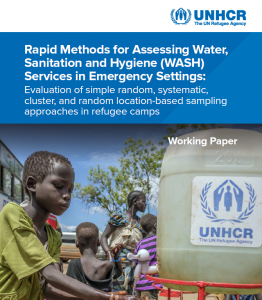
Publisher: UNHCR Year: 2017 Description: This document evaluates various sampling strategies that can be used during the emergency phase to estimate the status of WASH services in refugee camps or settlements. The working paper presents the results of statistical analyses carried out on real data from Ethiopia. The objective of the study was to evaluate […]
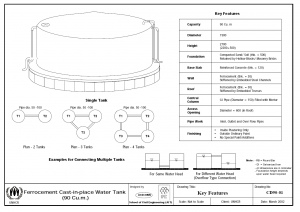
This document contains design drawings for a 90m3 circular water reservoir constructed from ferrocement.
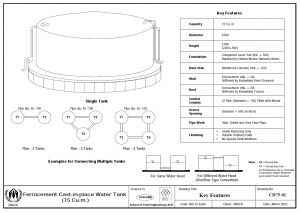
This document contains design drawings for a 75m3 circular water reservoir constructed from ferrocement.

This report is based on a desk-based review of secondary data, comprising published material as well as grey literature, supplemented with key informant interviews for programmes that lacked documentation. Section One summarises the current use of CBI in WASH programming. Section Two summarises the best practices and lessons learned including challenges faced, drawing on evidence from the project examples found. Section Three provides recommendations and best practice guidance for use of CBI in refugee settings. Section Four details existing tools and guidance.
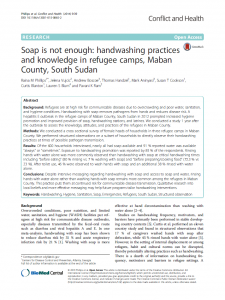
Refugees are at high risk for communicable diseases due to overcrowding and poor water, sanitation, and hygiene conditions. Handwashing with soap removes pathogens from hands and reduces disease risk. A hepatitis E outbreak in the refugee camps of Maban County, South Sudan in 2012 prompted increased hygiene promotion and improved provision of soap, handwashing stations, and latrines. We conducted a study 1 year after the outbreak to assess the knowledge, attitudes, and practices of the refugees in Maban County.

This report applies the life-cycle costs approach (LCCA) to the provision of water services in two UN refugee camps, Bambasi in Ethiopia and Kounoungou in Chad. It is based on cost data from financial reports in Geneva and both camps and on service-level data collected through the UNHCR monitoring system and on site through water point surveys.
The purpose of the study was (1) to better understand the structure, magnitude and drivers of the cost of providing a targeted level of water service to refugees, and (2) to reflect on the applicability of LCCA in the UNHCR monitoring framework and the potential for implementing it in systematically.

This document contains guidelines to help WASH actors in refugee settings select household water treatment products. The document includes an overview of: • Categories of HWTS; • Health benefits; • When to use HWTS and existing decision tree; • Criteria regarding HWT to be considered by the field; • Mandatory components; • UNHCR Checklist for HWTS; • HWT concerns; • Household water treatment cards; • Safe water storage;• Further reading; • Acknowledgement
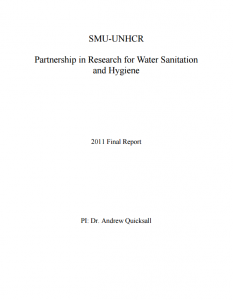
The SMU team conducted five sampling missions to UNHCR refugee camps in Uganda, Kenya, Bangladesh, Djibouti, and Liberia. Overall, these missions were considered a success with 17 camps, 7 villages, and a few additional sites visited. The team collected 213 camp samples and 229 total samples for analyses in the laboratory. Camp conditions and source water characteristics varied widely amongst the five countries but also within the camps themselves.
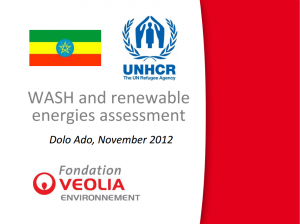
This document looks at drinking water, sanitation and renewable energy solutions and options in three camps in Dolo Odo with recommendations and conclusions.
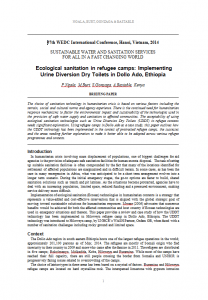
The choice of sanitation technology in humanitarian crisis is based on various factors including the terrain, social and cultural norms and agency experience. There is the continued need for humanitarian response mechanisms to factor the environmental impact and sustainability of the technologies used in the provision of safe water supply and sanitation to affected communities. The acceptability of using ecological sanitation technologies such as Urine Diversion Dry Toilets (UDDT) in refugee contexts needs significant exploration. Using refugee camps in Dollo Ado as a case study, this paper outlines how the UDDT technology has been implemented in the context of protracted refugee camps, the successes and the areas needing further exploration to make it better able to be adopted across various refugee programmes and contexts.
Tags: Excreta / Urine ReUse, Excreta / Urine ReUse, Excreta Composting, Excreta Composting, Excreta Management, Excreta Management, and Excreta Treatment. Locations: Africa, Africa, Africa, Africa, Dollo Ado, Dollo Ado, East and Horn of Africa, East and Horn of Africa, East and Horn of Africa, Ethiopia, Ethiopia, and Ethiopia. Languages: English, English, English, English, English, English, English, English, English, and English. Organisations: CDC, OXFAM GB, UNHCR, UNHCR, UNHCR, UNHCR, UNHCR, UNHCR, UNHCR, UNHCR, UNHCR, and WEDC. Categories: WASH Reference Documents, WASH Reference Documents, WASH Reference Documents, WASH Reference Documents, WASH Reference Documents, and WASH Reference Documents.
 English
English










